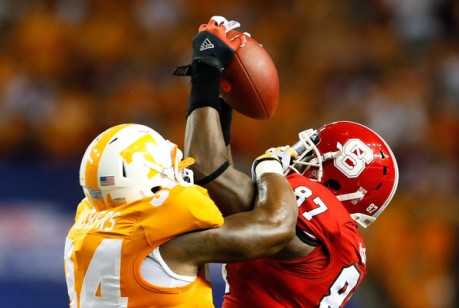Just as the Third Saturday in October post did a few weeks ago, let’s take a look at games from five, ten, 20 and 30 years ago in the Deep South’s Oldest Rivalry. All were Georgia victories.
Auburn leads the series 54-53-8, but Georgia enters as a 15-point favorite tomorrow night on the Plains seeking to tie the overall record. The Tigers have led the series since 1988.
2007: #10 Georgia 45, #17 Auburn 20 (Athens)
Known as the Blackout Game on the Georgia side, the Bulldogs wore black jerseys for the first time in the modern era and jumped out to a 17-3 lead in the 2nd quarter. But Auburn responded and took a 20-17 lead in the 3rd quarter. A 24-yard touchdown run by RB Knowshon Moreno put the Bulldogs back on top for good as they ran off 28 consecutive points to end the game.
Georgia finished #2 after the bowl games behind fellow conference member and national champion LSU. They wore black jerseys again in the Sugar Bowl defeating Hawaii. Meanwhile, Auburn defeated Clemson in the Chick-fil-A Bowl, finishing 9-4 and #15.
Georgia’s “black magic” came to a screeching halt in 2008 against Alabama and in 2009 against Florida as they wore black helmets for the first time.
2002: #7 Georgia 24, #24 Auburn 21 (Auburn)
Georgia clinched its first SEC Eastern Division championship with its comeback win on the Plains. QB David Greene hit WR Michael Johnson in the back of the end zone on 4th-and-15 for the game winner. The Bulldogs defeated Arkansas 30-3 in the SEC Championship Game to secure Georgia’s first SEC Championship in 20 years. The Bulldogs beat Florida State in the Sugar Bowl, finishing 13-1 and #3 in the polls.
Auburn defeated Penn State in the Capital One Bowl, finishing 9-4 and #14.
Legendary Georgia Bulldog announcer Larry Munson on the call:
1992: #12 Georgia 14, Auburn 10 (Auburn)
Ray Goff’s best Georgia team (10-2) beat Pat Dye’s last Auburn team (5-6) as Georgia defenders laid on the pile as time expired on Auburn’s offense at the 1-yard line. Nine years later in 2001, Auburn defeated Georgia 24-17 in Athens in very similar fashion as Auburn defenders did the same thing at the 1-yard line.
After Georgia’s win in 1992, the Bulldogs defeated Ohio State (with QB Kirk Herbstreit and RB Robert Smith — yes, today’s ESPN analysts) in the Citrus (Capital One) Bowl and finished #8. Auburn lost to #1 Alabama and didn’t go bowling.
Two videos here — the first includes an image of Goff directing his players to lay down and the second includes Georgia announcer Larry Munson’s “Old Lady Luck” call of the play:
1982: #1 Georgia 19, Auburn 14 (Auburn)
In the days before an SEC Championship Game, many Auburn-Georgia games decided the fate of one’s chances to claim the conference crown. Such was the case in 1982 as Georgia was seeking its third consecutive SEC championship and was the #1 team in the country. Auburn was 7-2 in Pat Dye’s second year and trending up.
Auburn QB Randy Campbell and RB Lionel “Little Train” James led a late Auburn drive that ended as Georgia broke up a 4th down pass in the end zone.
#2 Penn State (with QB Todd Blackledge — another ESPN analyst) defeated #1 Georgia in the Sugar Bowl 27-23 for the 1982 national championship. Meanwhile, Auburn beat Alabama for the first time in ten years as freshman RB Bo Jackson scored late, and the Tigers beat Boston College in the Tangerine Bowl to finish 9-3 and #14.
Another Larry Munson call and he looks back on the 1982 Auburn-Georgia game:
















